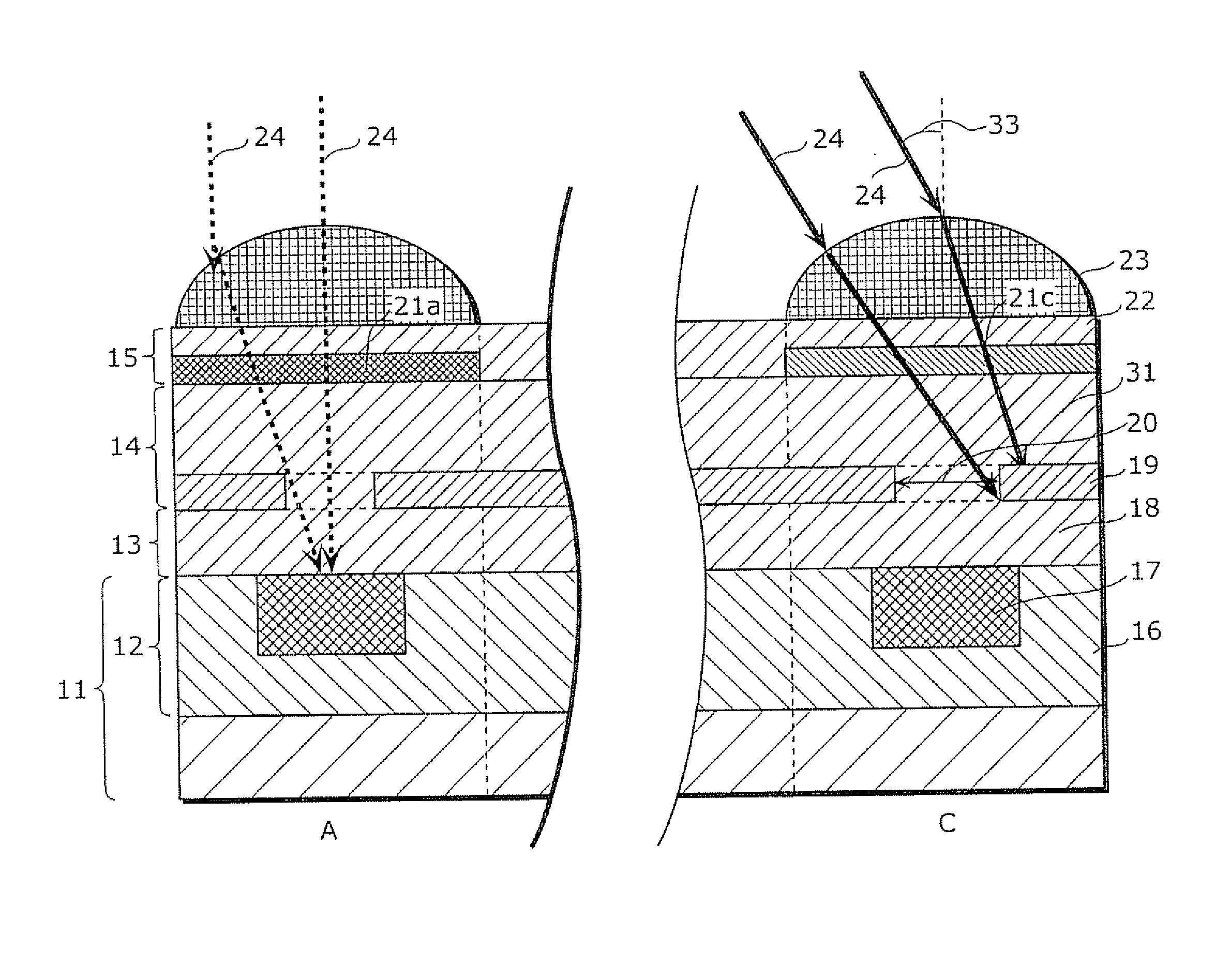Solid-state image sensor and manufacturing method thereof
a solid-state image and sensor technology, applied in the direction of electrical equipment, semiconductor devices, radio frequency control devices, etc., can solve the problems of difficult to make the red (r) light pass through the aperture and reach the photoelectric conversion unit, and the difficulty of condense light which has passed through each filter film into the aperture, etc., to achieve small aperture width, small aperture width, and light-condensing efficiency
- Summary
- Abstract
- Description
- Claims
- Application Information
AI Technical Summary
Benefits of technology
Problems solved by technology
Method used
Image
Examples
second embodiment
[0150]FIG. 11 is a cross-section diagram of the light-receiving cells 211a, 211b and 211c in a solid-state image sensor according to the second embodiment of the present invention. The semiconductor substrate 11, the photoelectric conversion layer 12 and the insulating layer 13 of each light-receiving cell has the same configuration as in the conventional light-receiving cell shown in FIG. 3.
[0151] While a metal layer 214 includes a light-blocking film 19 as in the case of the conventional solid-state image sensor, in the solid-state image sensor according to the second embodiment of the present invention, the metal layer 214 has a high refractive index layer 225 that is formed by applying a high refractive index material in and on an aperture 20 in the light-blocking film 19 after the formation of the light-blocking film 19. Herein, the high-refractive index layer 225 is processed into a shape of a convex intralayer lens. Accordingly, the interlayer film 29 and the intralayer lens...
third embodiment
[0161]FIG. 13 is a cross-section diagram of the light-receiving cells 311a, 311b and 311c in a solid-state image sensor according to the third embodiment of the present invention.
[0162] The solid-state image sensor of the third embodiment is is different from the solid-state image sensor of the first embodiment in that the insulating layer 13, the metal layer 114 and the microlens 23 have the same refractive index value.
[0163] In the solid-state image sensor of the third embodiment, a light-receiving cell having a longer transmission wavelength of a filter has higher refractive indexes of the insulating film 13, an insulating layer in the metal layer 114 and a microlens 23. In addition, light receiving cells having different transmission wavelengths of respective filters have different refractive indexes of the insulating layer 13, insulating layer in the metal layer 114, and microlens 23. For example, in the light-receiving cell having a longer transmission wavelength of a filter...
fourth embodiment
[0164]FIG. 14 is a cross-section diagram of the light-receiving cells 411a, 411b and 411c in a solid-state image sensor according to the fourth embodiment of the present invention. The semiconductor substrate 11, photoelectric conversion layer 12, insulating layer 13, and metal layer 14 and color filter 15 of each light-receiving cell in the fourth embodiment has the same configuration as in the conventional solid-state image sensor shown in FIG. 3 except that the intralayer lens 30 is not formed in the metal layer 14 in the present embodiment.
[0165] The solid-state image sensor of the fourth embodiment has a configuration in which a refractive index of a material which composes the microlens 423 formed on the color filter layer 15 differs in accordance with a transmission wavelength band of a color filter.
[0166] Here, the finer the light-receiving cells are, the narrower the widths of the apertures 20 become. For example, when the width of the aperture 20 is 2 μm or smaller, it i...
PUM
 Login to View More
Login to View More Abstract
Description
Claims
Application Information
 Login to View More
Login to View More - R&D
- Intellectual Property
- Life Sciences
- Materials
- Tech Scout
- Unparalleled Data Quality
- Higher Quality Content
- 60% Fewer Hallucinations
Browse by: Latest US Patents, China's latest patents, Technical Efficacy Thesaurus, Application Domain, Technology Topic, Popular Technical Reports.
© 2025 PatSnap. All rights reserved.Legal|Privacy policy|Modern Slavery Act Transparency Statement|Sitemap|About US| Contact US: help@patsnap.com



